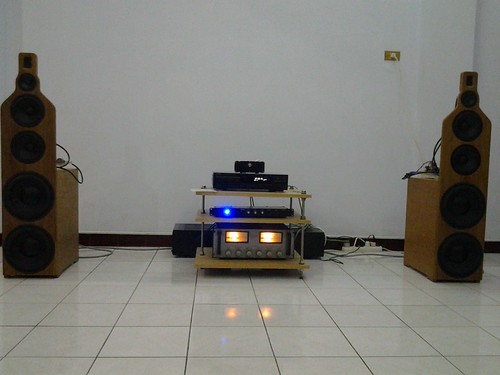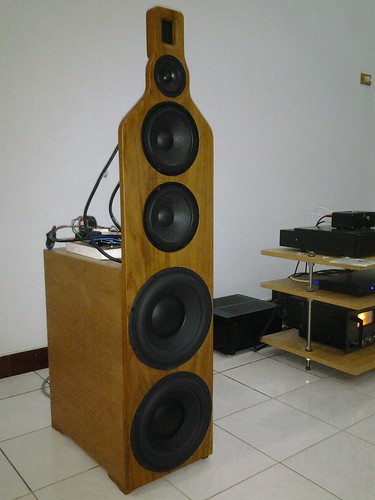After a year long, it finally came to life and sings beautifully. Have to say definitely worth the wait and effort.




Hi Hans,
The system look good. Thanks for the effort and the confidence to invest in one of my designs. I can't see the back side clearly but it looks like you still need to install the baffle braces. I'm glad you are pleased with the result. Hopefully you will get many years of enjoyment listening to the system.
The system look good. Thanks for the effort and the confidence to invest in one of my designs. I can't see the back side clearly but it looks like you still need to install the baffle braces. I'm glad you are pleased with the result. Hopefully you will get many years of enjoyment listening to the system.
Nice one darbost! Looks great! Any specifics on the sound you can comment on? What were you listening to before you finished these?
After a year long, it finally came to life and sings beautifully. Have to say definitely worth the wait and effort.
That's gorgeous Pak 🙂
What wood (Kayu Jati??)
Are there any plans to allow for different midwoofers of the same size? Not that I'm saying the ER18RNX is a bad choice by any means.
Are there any plans to allow for different midwoofers of the same size? Not that I'm saying the ER18RNX is a bad choice by any means.
No. If I ever change the mids the ER18 version would be discontinued. But I don't anticipate that happening. I prefer to keep my designs fixed.
I would more likely add a third design to my line before changing the Note.
Based on the physical dimensions of the 10F/4424G00, the dipole peak should be around 3 kHz with the inclusion of the (very narrow) baffle. Your crossover is at 6 kHz. Isn't the off-axis response supposed to bloom when nearing/exceeding the dipole peak frequency? However, this phenomenon is not shown in your measurements.
Interested to see what your next design will be. This one is just so thoroughly amazing.
Interested to see what your next design will be. This one is just so thoroughly amazing.
Based on the physical dimensions of the 10F/4424G00, the dipole peak should be around 3 kHz with the inclusion of the (very narrow) baffle. Your crossover is at 6 kHz. Isn't the off-axis response supposed to bloom when nearing/exceeding the dipole peak frequency?
Don't forget that the driver itself is becoming increasingly directive which is reducing its off axis response. There would be a theoretical bloom at the crossover because of the ""baffle"" dimensions, but John solved that issue with the waveguide on the tweeter as far as I can tell.
Interested to see what your next design will be. This one is just so thoroughly amazing.
It's a RAAL short of being the greatest looking speaker design in the history of mankind!! okay that's pushing it but it's truly a work of art. Do you feel the Scanspeak 10F is free of subjective colorations, John?
Hi Hans,
The system look good. Thanks for the effort and the confidence to invest in one of my designs. I can't see the back side clearly but it looks like you still need to install the baffle braces. I'm glad you are pleased with the result. Hopefully you will get many years of enjoyment listening to the system.
Yup, haven't install the braces yet. Work hasn't done completely yet. Still need to give finishing touch.
That's gorgeous Pak 🙂
What wood (Kayu Jati??)
Wow, sharp eye. Yep, the baffle made from old teak/kayu jati.
Nice one darbost! Looks great! Any specifics on the sound you can comment on? What were you listening to before you finished these?
When listening with eyes closed, the first thing I noticed is there's no gap between left, right, and center. It made me think this is open baffle people talk about. Soundstage and instrument positioning are great as well. I've played several genres (pop, instrumental, and jazz), it handles all beautifully.
Generally, the sound feels warm while preserving the details like after tone i.e. not fatigues.
Previously, I was more into headphone thing. Listened to AKG K701, balanced Sennheiser HD650, Beyerdynamics DT880, Audio-Technica L3000. But lately moved to speaker. Listened to Scott Lindgren's Victor, an old pair of Mordaunt Short, Dali Lektor, old pairs of JBL, 5.1 Jamo, and many unbranded cheap speakers.
I'm not talking about the tweeter but the mid, though I see your point about beaming compensating for the dipole bloom. Interesting how he got it to work out for a flat polar response, though.Don't forget that the driver itself is becoming increasingly directive which is reducing its off axis response. There would be a theoretical bloom at the crossover because of the ""baffle"" dimensions, but John solved that issue with the waveguide on the tweeter as far as I can tell.
The other thing is that he sacrificed a larger vertical listening window for something else that required a high mid-to-tweet crossover. I wonder what it was and why it was preferable to a lower crossover.I'm not talking about the tweeter but the mid, though I see your point about beaming compensating for the dipole bloom. Interesting how he got it to work out for a flat polar response, though.
For dipoles with very small baffles you can't rely on textbook design above 2 kHz. That's my experience. The influence of the backward radiation on the frontal response can't be neglected any more - and it does funny things.Based on the physical dimensions of the 10F/4424G00, the dipole peak should be around 3 kHz with the inclusion of the (very narrow) baffle. Your crossover is at 6 kHz. Isn't the off-axis response supposed to bloom when nearing/exceeding the dipole peak frequency?
I'm not talking about the tweeter but the mid, though I see your point about beaming compensating for the dipole bloom. Interesting how he got it to work out for a flat polar response, though.
I'm sure NaO's 4" is fine crossed at 6khz. John's measurement has shown this. As comparison, I have 3" Tangband, and measured naked it has dipole bloom at 10khz:

Based on the physical dimensions of the 10F/4424G00, the dipole peak should be around 3 kHz with the inclusion of the (very narrow) baffle. Your crossover is at 6 kHz. Isn't the off-axis response supposed to bloom when nearing/exceeding the dipole peak frequency? However, this phenomenon is not shown in your measurements.
Interested to see what your next design will be. This one is just so thoroughly amazing.
If you look closely at the polar plots you will see that there is some broadening in the 2-4k region particularly. However, as RockleeEV, the ss10F is becoming directional at that point and that helps keep things in check. It is a balance between baffle size and driver characteristics. I knew going into the design that it would not be perfect (what is?), but the objective was to do better than just going from a typically midrange to a dome tweeter. I tested a lot of baffles and a number of small drivers, including the Tang Band W4 Titanium, before settling on the 10F. I felt it was the 10F best of the bunch in achieving my design goals. It is very neutral and has good distortion characteristics over the range I am using it.
Regarding the x-o at 6k. Yep, it is a trade off. You have to give in one area to get in another. I played around with the x-o frequency considerably using the Ultimate Equalizer. Using it I could virtually change crossover points in seconds and have the exact same axial response. Ultimately I build passive crossovers with 4k and 6k crossover points and listened at length. The 6k sound better to me. While it is true that gated measurement will show a dip at 6k as the mic is moved off axis vertically, the in room response is pretty smooth and the speaker sounds pretty much the same sitting or standing. But it is designed with the expectation that the listeners will be seated.
I will say, what ever I do next, if I do something, it will be all active with dsp crossover. In particular, the miniDSP 2x8. It is just getting too expensive to design and build the analog active x-o's and it is getting harder and harder to source the required caps. Places like DigiKey and Mouser are cutting way back on the values they stock making it harder for DIYers to get the required parts.
Have you read or heard why? Seems odd for big parts warehouses such as these to limit stock this way.I will say, what ever I do next, if I do something, it will be all active with dsp crossover. In particular, the miniDSP 2x8. It is just getting too expensive to design and build the analog active x-o's and it is getting harder and harder to source the required caps. Places like DigiKey and Mouser are cutting way back on the values they stock making it harder for DIYers to get the required parts.
Dave
Hi Dave,
I may be completely wrong but I think manufacturers are moving more towards surface mount technology.
The active designs need ultra tight tolerance components for easy domestic builds.
I built Pluto with all 1% tolerance components. That is a fairly specialist requirement.
Large manufacturers can buy and test batches of cheaper wide tolerance components. Sell on or even bin what they do not use.
I may be completely wrong but I think manufacturers are moving more towards surface mount technology.
The active designs need ultra tight tolerance components for easy domestic builds.
I built Pluto with all 1% tolerance components. That is a fairly specialist requirement.
Large manufacturers can buy and test batches of cheaper wide tolerance components. Sell on or even bin what they do not use.
Last edited:
Hi Dave,
I may be completely wrong but I think manufacturers are moving more towards surface mount technology.
The active designs need ultra tight tolerance components for easy domestic builds.
I built Pluto with all 1% tolerance components. That is a fairly specialist requirement.
Large manufacturers can buy and test batches of cheaper wide tolerance components. Sell on or even bin what they do not use.
I agree, I think it reflects the move towards surfaced mounted designs. The demand for high tolerance, low voltage caps for through hole mounting just isn't there any more and I think the suppliers don't want to hold a lot of inventory that isn't going to move.
For dipoles with very small baffles you can't rely on textbook design above 2 kHz. That's my experience. The influence of the backward radiation on the frontal response can't be neglected any more - and it does funny things.
You have to explain Rudolf, no baffle, small baffle, narrow baffle all unpredictable ?
I didn't know of any 'textbook' other than your ? 🙂
/Erling
6K is the acoustic crossover I assume, can I ask what the electronic crossover frequencies are please?
I am using a PLLXO for my SS10F to neo3PDR. Otherwise my system is alpha 15s and a Monacor 8", which is working great for me.
I am using a PLLXO for my SS10F to neo3PDR. Otherwise my system is alpha 15s and a Monacor 8", which is working great for me.
- Status
- Not open for further replies.
- Home
- Loudspeakers
- Multi-Way
- NaO Note preview